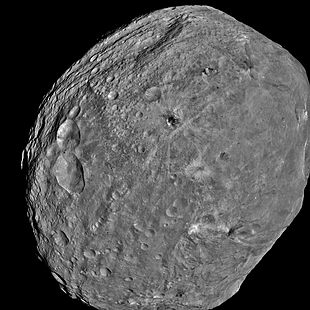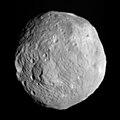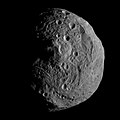(4) Vesta
|
Asteroid (4) Vesta |
|
|---|---|

|
|
| Image of the asteroid Vesta by the space probe Dawn from a distance of 5200 km (July 24, 2011) | |
| Properties of the orbit ( animation ) | |
| Orbit type | Main belt asteroid |
| Asteroid family | Vesta family |
| Major semi-axis | 2.362 AU |
| eccentricity | 0.089 |
| Perihelion - aphelion | 2.151 AU - 2.572 AU |
| Inclination of the orbit plane | 7.1 ° |
| Length of the ascending node | 103.8 ° |
| Argument of the periapsis | 150.9 ° |
| Time of passage of the perihelion | May 9, 2018 |
| Sidereal period of rotation | 3 a 230 d |
| Mean orbital velocity | 19.34 km / s |
| Physical Properties | |
| Medium diameter | 573 × 557 × 446 km |
| Dimensions | (2.5908 ± 0.00001) 10 20 kg |
| Albedo | 0.4228 |
| Medium density | 3.456 g / cm³ |
| Rotation period | 5,342 h |
| Absolute brightness | 3.20 mag |
|
Spectral class (according to Tholen) |
V |
|
Spectral class (according to SMASSII) |
V |
| history | |
| Explorer | H. Olbers |
| Date of discovery | March 29, 1807 |
| Source: Unless otherwise stated, the data comes from JPL Small-Body Database Browser . The affiliation to an asteroid family is automatically determined from the AstDyS-2 database . Please also note the note on asteroid items. | |
Vesta or - in the nomenclature for asteroids - (4) Vesta (pronunciation [ˈvεsta] ) is the second largest after Pallas with a mean diameter of around 516 km , but the heaviest asteroid in the main asteroid belt at around 2.6 · 10 20 kg , in which is only surpassed in mass by the dwarf planet Ceres . Vesta is - like Ceres and probably also Pallas - a protoplanet from the time the solar system was formed . It has a relatively large metal stake is slightly oval (possibly due to a collision in the early days) and is the only asteroid sometimes freiäugig is visible.
discovery
Vesta was discovered on March 29, 1807 by Heinrich Wilhelm Olbers in Bremen as the fourth asteroid. After Olbers had already discovered and named Pallas in 1802 , this time he transferred the right of naming to Carl Friedrich Gauß , who had made a decisive contribution to securing the newly discovered asteroids with his new method of smallest squares for determining the orbit . Gauss named the heavenly body after Vesta , the Roman goddess of home and hearth and sister of Ceres .
Like the dwarf planet Ceres, discovered in 1801, and the asteroids Pallas and Juno , discovered in 1802 and 1804, Vesta was also initially referred to as a planet . As it was still more than 38 years before Astraea was discovered , nothing changed at first. Only after about 1850, when the number of celestial bodies found between the orbits of the planets Mars and Jupiter rose rapidly, did the designations "small planets", "minor planets", "planetoids" or "asteroids" establish themselves.
Orbit
Vesta orbits the Sun between 2.15 AU ( perihelion ) and 2.57 AU ( aphelion ) in 3.63 years. Its orbit is 7.1 ° inclined to the ecliptic , the orbital eccentricity is 0.089. So its orbit lies in the inner asteroid belt .
The synodic period of Vesta is 504 days.
Meteorites and vestoids

Presumably Vesta is the mother body of the meteorites of the HED group (Howardite, Eukrite, Diogenite) , which form a subgroup of the achondrites , which are similar to the earthly igneous rocks. The connection between the HED meteorites and Vesta was established because the spectra of these meteorites and the asteroid are similar. This assignment is supported by the fact that all examined HED meteorites are between 4.4 and 4.5 billion years old. The parent body of these meteorites cooled down quickly after the formation of the solar system, which indicates a relatively small celestial body and rules out the origin of larger moons or planets . With Vesta are Vestoids associated comprise a class of smaller asteroids, which also spectral similarities to Vesta and may have been knocked away from the latter. It is believed that the Vestoids were knocked out of the crust of Vesta less than a billion years ago during the impact that formed the Rheasilva crater. The distribution of the Vestoids extends from the orbit of Vesta to regions in the asteroid belt that are subject to perturbations from the planet Jupiter. Fragments of Vesta could become earth orbit cruisers , and HED meteorites could also have been brought close to Earth. It is still unclear whether they come directly from Vesta or indirectly via a Vestoid.
nature
Size and brightness
The shape of Vesta corresponds to a triaxial ellipsoid with the radii 280 km, 272 km and 227 km (± 12 km). Vesta is not in hydrostatic equilibrium and is therefore not counted among the dwarf planets .
A value of 1.36 (± 0.05) × 10 −10 solar masses (2.71 × 10 20 kg ) and thus a mean density of 3.7 (± 0.3) was obtained for the mass from orbital disturbances of other asteroids g / cm³ calculated. The period of rotation of the asteroid is about 5.3 hours .
Vesta has a relatively bright surface compared to other asteroids with an albedo of 0.42. During opposition , it is between 1.14 AU and 1.59 AU from Earth and has an apparent magnitude of up to 5.2 mag . This makes it the brightest asteroid in the night sky and can barely be seen with the naked eye when the sky is dark and without light pollution .
Composition and surface
Vesta is a differentiated asteroid with a basaltic crust, ultramafic mantle rock and, as can be inferred from the mean density , an iron - nickel core. Vesta has a structure similar to that of the terrestrial planets and thus differs from all other asteroids in the main belt.
The iron meteorites found on Earth , however, allow the conclusion that there must have been other differentiated planetesimals in the early days of the solar system , which were apparently destroyed by collisions, because the iron meteorites are interpreted as fragments of the metallic cores of these objects.
Vesta must also have suffered severe collisions with other massive bodies. In addition to several impact craters with diameters of up to 150 km, an outstandingly large crater with a diameter of around 450 km can be seen on the images . This crater has a depth of 8 km (coded in blue in the figure opposite), its walls are also between 8 km and 14 km high, and in the middle a central mountain rises 13 km (red in the figure).
With the help of the Hubble space telescope it was not only possible to determine the shape and size of Vesta, but also light and dark regions on the surface could be recognized, even a rough geological map could be created. The surface seems to consist entirely of igneous rocks . The regions shown in green on the geological map were interpreted as basaltic solidified lava flows and thus represent remnants of the original surface of Vesta. The reddish-coded areas consist of intrusive rocks that initially cooled below the surface and were later exposed by impacts .
The geological activity of Vesta probably going to the radioactive decay of aluminum - Isotopes 26 Al liberated heat back and is expected before about 4.4 billion years ago, so relatively soon after the formation of the solar system from about 4.55 billion years ago, again Have succumbed.
Spectroscopic observations at the Mauna Kea Observatory showed that small amounts of water- or hydroxide-containing minerals exist on the surface of Vesta . It is believed that this material was deposited after the asteroid had cooled down when comets or carbonaceous chondrites impacted.
Surface structures
The southern hemisphere is dominated by two huge impact craters. Veneneia crater has a diameter of almost 400 km, the later overlapping larger crater Rheasilvia has a diameter of 505 km, which corresponds to 90% of the diameter of Vesta. This makes it one of the largest craters in the solar system. The central mountain in the middle of Rheasylvia rises to a height of 22 km above the ground, making it one of the highest mountains in the solar system, along with Olympus Mons on Mars. The impact allows insight into the area of the mantle rock. One consequence of the impact is a deep rift called Divalia Fossa , which extends around the entire asteroid in the area of the equator. The Saturnalia Fossa rift valley was formed by the impact of Veneneia .
Exploration by the Dawn spacecraft

Vesta was the first target of the Dawn spacecraft launched on September 27, 2007. Through Dawn, the previous knowledge was significantly expanded and refined through earth-based observations of the asteroids. On July 15, 2011, the probe went into orbit around Vesta. The task of the probe consisted of taking color photographs, compiling a topographical map, investigating the elementary composition of the surface, creating a geological map according to rock types, investigating the gravitational field and searching for possible moons. First, Dawn provided a complete overview of Vesta from 2,750 kilometers, followed by three phases of mapping with many detailed observations. The first from a height of 680 kilometers, another from 180 kilometers and a third again from 680 kilometers at a different angle. In the meantime, seasonal changes and structures at the North Pole that were initially in the dark became visible.
Ralf Jaumann's working group from the German Aerospace Center (DLR) created a 3D video from images taken between July and August 2011 during the approach and from an altitude of 2700 km . During the virtual overflight, a mountain about 25 km high can be seen at the South Pole, which is almost three times as high as Mount Everest . Olympus Mons on Mars is at a similar altitude .
Dawn explored the planetoid until September 5, 2012 and then flew on to Ceres , which she reached in March 2015.
Dawn spacecraft
Research results since the Dawn mission
According to research results published by the University of Bern in July 2014, no evidence of the mineral olivine was found on the surface of the large craters. According to model calculations, this mantle rock should have been present at the large impact craters. This apparently means that the asteroid's crust is much thicker than previously thought. According to estimates, that's more than 80 km. The dimensions of the internal structure shift accordingly, because the underlying jacket, which envelops the core, then has to be much thinner. It is therefore possible that the composition and development of Vesta should be reconsidered.
nomenclature
According to the IAU nomenclature, structures on Vesta are named as follows:
- Craters are named after historical names associated with the goddess Vesta and famous Roman women.
- Regions are named after the discoverer of Vesta and scientists who were involved in the exploration of Vesta.
- Other structures are named after locations associated with vestal virgins .
On September 30, 2011, the IAU first recognized the designation of 14 craters and one tholus . The named structures have a diameter of 0.57 km ( Claudia ) to 450 km ( Rheasylvia ).
See also
literature
- Clifford J. Cunningham: Investigating the Origin of the Asteroids and Early Findings on Vesta. Springer, 2017, ISBN 978-3-319-86326-9
Web links
- Vestatrek - Fully integrated 3-D map of all available data sets from (4) Vesta
- (4) Vesta in the database of the "Asteroids - Dynamic Site" (AstDyS-2, English).
- When Did the Asteroids Become Minor Planets? (English)
- What did Dawn learn at Vesta? (English)
- NASA's Dawn Views Vesta: Vesta Full Rotation Movie on YouTube (English)
- Target: Vesta (page with links to lists of named structures, downloadable data sets and a current Vesta map with names and locations of previously named structures) (English)
- DLR animation: Overflight over the asteroid Vesta September 16, 2011
Individual evidence
- ↑ Max Mangold (arrangement): Duden. The pronunciation dictionary (6th edition), Dudenverlag, Mannheim 2005, ISBN 3-411-04066-1 , p. 818.
- ↑ Helmut Boor (ed.): Theodor Siebs - Deutsche Hochsprache (18th edition), de Gruyter, Berlin 1966, p. 348
- ^ TB McCord, LA McFadden, CT Russell, C. Sotin, PC Thomas: Ceres, Vesta, and Pallas: Protoplanets, Not Asteroids . In: Transactions of the American Geophysical Union . 87, No. 10, 2006, p. 105. bibcode : 2006EOSTr..87..105M . doi : 10.1029 / 2006EO100002 .
- ^ BE Schmidt, PC Thomas, JM Bauer, J.-Y. Li, LA McFadden, JM Parker, AS Rivkin, CT Russell, SA Stern: Hubble takes a look at Pallas: Shape, size, and surface . (PDF) In: 39th Lunar and Planetary Science Conference (Lunar and Planetary Science XXXIX). Held March 10-14, 2008, in League City, Texas. . 1391, 2008, p. 2502. bibcode : 2008LPI .... 39.2502S . Retrieved August 30, 2016.
- ↑ Mike Wall: Huge Asteroid Vesta Actually an Ancient Protoplanet. In: space.com. May 10, 2012, accessed November 17, 2015 .
- ^ Lutz D. Schmadel : Dictionary of Minor Planet Names. 5th edition, Springer, Berlin / Heidelberg / New York / u. a. 2003, ISBN 3-540-00238-3
- ^ HY Mc. Sween: Meteorites and Their Parent Planets. Cambridge University Press, (2nd edition, 1999), ISBN 0-521-58303-9 .
- ^ E. Asphaug: Impact origin of the Vesta family. In: Meteoritics & Planetary Science . Volume 32, No. 6, pp. 965-980 (11/1997), bibcode : 1997M & PS ... 32..965A .
- ^ F. Migliorini, A. Morbidelli, V. Zappala, BJ Gladman, ME Bailey, A. Cellino: Vesta fragments from v6 and 3: 1 resonances: Implications for V-type NEAs and HED meteorites. In: Meteoritics & Planetary Science. Volume 32, No. 6, pp. 903-916 (11/1997). bibcode : 1997M & PS ... 32..903M .
- ↑ PC Thomas, RP Binzel, MJ Gaffey, BH Zellner, AD Storrs, E. Wells: Vesta: Spin Pole, Size, and Shape from HST Images. In: Icarus. Volume 128, No. 1, pp. 88-94 (07/1997) doi: 10.1006 / icar.1997.5736
- ↑ G. Michalak: Determination of asteroid masses - I. (1) Ceres, (2) Pallas and (4) Vesta. In: Astronomy and Astrophysics. Volume 360, pages 363-374 (08/2000), aa.springer.de: Astron. Astrophys. 360, 363-374 (2000) , accessed June 19, 2010
- ↑ K. Wedge, Geological History of Asteroid 4 Vesta: The “Smallest Terrestrial Planet”. In: Asteroids III. William Bottke, Alberto Cellino, Paolo Paolicchi, and Richard P. Binzel, (editors), Univ. of Arizona Press (2002), ISBN 0-8165-2281-2 .
- ↑ RP Binzel, MJ Gaffey, PC Thomas, BH Zellner, AD Storrs, EN Wells: Vesta: Impact Crater Topography from Hubble Space Telescope WFPC2 Images. In: Bulletin of the American Astronomical Society. Volume 29, page 973 (American Astronomical Society, DPS meeting # 29, 1997) lpi.usra.edu: Vesta: Impact Crater Topography from Hubble Space Telescope WFPC2 Images , accessed June 19, 2010
- ↑ RP Binzel, MJ Gaffey, PC Thomas, BH Zellner, AD Storrs, EN Wells: Geologic Mapping of Vesta from 1994 Hubble Space Telescope Images. In: Icarus. Volume 128, No. 1, pp. 95-103 (07/1997) doi: 10.1006 / icar.1997.5734
- ↑ S. Hasegawa, K. Murakawa, M. Ishiguro, H. Nonaka, N. Takato, CJ Davis, M. Ueno, T. Hiroi: Evidence of hydrated and / or hydroxylated minerals on the surface of asteroid 4 Vesta. In: Geophysical Research Letters. Volume 30, No. 21 (11/2003) doi: 10.1029 / 2003GL018627
- ↑ a b Dawn Soars Over Asteroid Vesta in 3-D. Retrieved September 17, 2017 (English).
- ↑ Dawn at Vesta - Press Kit / July 2011. (PDF) NASA, July 2011, p. 10 , accessed on March 27, 2017 (English).
- ↑ Dawn at Vesta - Press Kit / July 2011. (PDF) NASA, July 2011, pp. 14–16 , accessed on March 27, 2017 (English).
- ↑ Soar Over Asteroid Vesta in 3-D. Retrieved September 17, 2017 (English).
- ↑ DAWN: Probe in orbit around the dwarf planet Ceres. Press release from the German Aerospace Center. astronews.com, March 6, 2015, accessed March 7, 2015 .
- ↑ Mission News: Dawn Gets Extra Time to Explore Vesta. Retrieved June 19, 2012 (English).
- ↑ NASA's Dawn Spacecraft Hits Snag on Trip to 2 Asteroids. Retrieved August 27, 2012 .
- ^ Jia-Rui C. Cook: Dawn has departed the giant asteroid Vesta. In: www.jpl.nasa.gov. Jet Propulsion Laboratory , California Institute of Technology , September 5, 2012, accessed December 1, 2017 .
- ↑ Nathalie Matter: Asteroid Vesta reveals surprising things about the formation of planets , IDW-Online article from July 16, 2014, accessed on April 10, 2015
- ↑ Categories for Naming Features on Planets and Satellites ( Memento of December 5, 2017 in the Internet Archive ) (accessed November 11, 2011), (English)
- ↑ Vesta ( Memento from June 17, 2018 in the Internet Archive ) in the Gazetteer of Planetary Nomenclature of the IAU (WGPSN) / USGS . Accessed November 21, 2015







